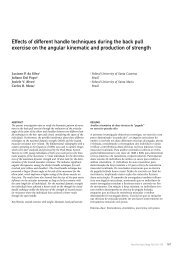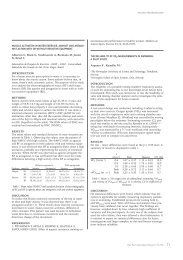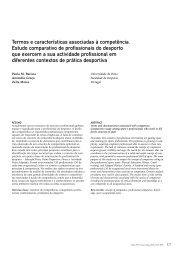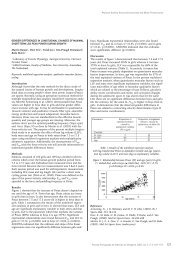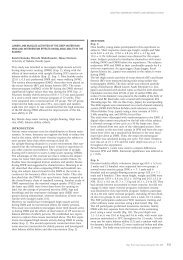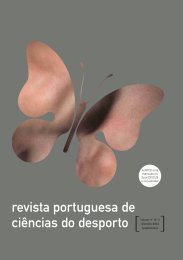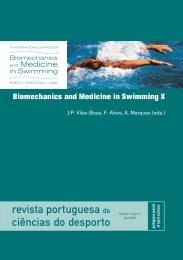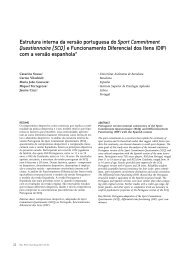download PDF - Faculdade de Desporto da Universidade do Porto
download PDF - Faculdade de Desporto da Universidade do Porto
download PDF - Faculdade de Desporto da Universidade do Porto
You also want an ePaper? Increase the reach of your titles
YUMPU automatically turns print PDFs into web optimized ePapers that Google loves.
238<br />
A<strong>de</strong>lino Silva, Vanessa Santhiago, Cláudio Gobatto<br />
55. Luger A, Deuster PA., Kyle SB, Gallucci WT, Montgomery<br />
LC, Gold PW, Lynn-Loriaux D, Chrousos GP (1987). Acute<br />
hypothalamic-pituitary-adrenal responses to the stress of<br />
treadmill exercise. N Engl J Med 316: 1309-1315<br />
56. Mackinnon LT (2000). Overtraining effects on immunity<br />
and performance in athletes. Immunol Cell Biol 78: 502-509<br />
57. Mackinnon LT, Hooper SL (1996). Plasma glutamine and<br />
upper respiratory tract infection during intensified training<br />
is swimmers. Med Sci Sports Exerc 28: 285-90<br />
58. Mackinnon LT, Hooper SL, Jones S, Gor<strong>do</strong>n RD, Bachmann<br />
A (1997). Hormonal, immunological, and hematological<br />
responses to intensified training in swimmers. Med Sci<br />
Sports Exerc 29: 1637-1645<br />
59. Matvienko LA (1981). A study of peripheral blood in track<br />
and field athletes. Sov Sports Rev 16: 50-51<br />
60. McNair DM, Lorr M, Droppleman LF (1971). Profile of<br />
mood states manual. San Diego: Educational and Industrial<br />
Testing Services<br />
61. Miazaki H, Oh-ishi S, Ookawara T, Kizaki T, Toshinai K,<br />
Ha S, Haga S, Ji LL, Ohno H (2001). Strenuous endurance<br />
training in humans reduce oxi<strong>da</strong>tive stress following<br />
exhausting exercise. Eur J Appl Physiol 84:1-6<br />
62. Morgan WP, Brown DR, Raglin JS, O’Connor PJ, Ellickson<br />
KA (1987). Physiological monitoring of overtraining and<br />
staleness. Br J Sports Med 21: 107-114<br />
63. Newhouse IJ, Clement DB (1988). Iron status in athletes,<br />
an up<strong>da</strong>te. Sports Med 5: 337-352<br />
64. Newsholme EA (1994). Biochemical mechanisms to<br />
explain immunosopression in well-trained and overtrained<br />
athletes. Int J Sports Med 15: 142-147<br />
65. Noakes T (1991). Lore of Running. Champaign, IL: Human<br />
Kinetics, 408-425<br />
66. O’ Connor PJ, Morgan WP, Raglin JS, Barks<strong>da</strong>le CM, Kalin<br />
NH (1989). Mood state and salivary cortisol levels following<br />
overtraining in female swimmers.<br />
Physichoneuroen<strong>do</strong>crinology 14: 303-310<br />
67. Ostrowski K, Hermann C, Bangash A, Schjerling P, Nielsen<br />
JN, Pe<strong>de</strong>rsen BK (1998). A trauma-like elevation in plasma<br />
cytokines in humans in response to treadmill running. J<br />
Physiol (Lond) 508:949-953<br />
68. Ostrowski K, Roh<strong>de</strong> T, Asp S, Schjerling P, Pe<strong>de</strong>rsen BK<br />
(1998). The cytokine balance and strenuous exercise:<br />
TNF-alpha, IL-2beta, IL-6, IL-1ra, sTNF-r1, sTNF-r2, and<br />
IL-10. J Physiol (Lond) 515:287-291<br />
69. Pe<strong>de</strong>rsen BK, Roh<strong>de</strong> T, Ostrowski K (1998). Recovery of<br />
the immune system after exercise. Acta Physiol Scand<br />
162:325-332<br />
70. Peluso MAM (2003). Alterações <strong>de</strong> humor associa<strong>da</strong>s à<br />
ativi<strong>da</strong><strong>de</strong> física intensa. Tese (Doutora<strong>do</strong>)-<strong>Facul<strong>da</strong><strong>de</strong></strong> <strong>de</strong><br />
Medicina, Universi<strong>da</strong><strong>de</strong> <strong>de</strong> São Paulo: São Paulo.<br />
71. Petibois C, Cazola G, Poortmans JB, Deleris G (2002).<br />
Biochemical aspects of overtraining in endurance sports: a<br />
review. Sports Med 32: 867-878<br />
72. Pra<strong>da</strong> FJA, Voltarelli FA, Oliveira CAM, Gobatto CA,<br />
Mace<strong>do</strong> DV, Mello MAR (2004). Condicionamento aeróbio<br />
e estresse oxi<strong>da</strong>tivo em ratos treina<strong>do</strong>s por natação em<br />
intensi<strong>da</strong><strong>de</strong> equivalente ao limiar anaeróbio. Rev Bras Cien<br />
Mov 12: 29-34<br />
73. Pyne DB, Baker MS, Fricker PA, MacDonald WA, Telford<br />
RD, Wei<strong>de</strong>mann MJ (1995). Effects of an intensive 12 wk<br />
training program by elite swimmers on neutrophil oxi<strong>da</strong>se<br />
activity. Med Sci Sports Exerc 27: 536-542<br />
Rev Port Cien Desp 6(2) 229–238<br />
74. Rivier A, Pene J, Chanez P, Anselme F, Caillaud C, Pre-Faut<br />
C, Go<strong>da</strong>rd P, Bousquet J (1994). Release of Cytokines by<br />
blood monocytes during strenuous exercise. Int J Sports<br />
Med 15:192-198<br />
75. Rossi L, Tirapegui J (1999). Aspectos atuais sobre exercício<br />
físico, fadiga e nutrição. Rev Pauli Ed Fís 13:.67-82<br />
76. Seene T, Umnova M, Kaasik P (1999). The exercise myopathy.<br />
In: Lehmann M, Foster C, Gastmann U, Keizer H,<br />
Steinacker J (ed). Overload, Performance Incompetence and<br />
Regeneration in Sport. New York: Kluwer Aca<strong>de</strong>mic/Plenum<br />
Publishers, 119-130<br />
77. Smith JA (1995). Exercise, training, and red cell turnover.<br />
Sports Med 19: 9-31<br />
78. Smith JA, Telford RD, Mason IB, Wei<strong>de</strong>mann MJ (1990).<br />
Exercise, training and neutrophil microbici<strong>da</strong>l activity. Int J<br />
Sports Med 11: 179-87<br />
79. Smith LL (2000). Cytokine hypothesis of overtraining: a<br />
physiological a<strong>da</strong>ptation to excessive stress? Med Sci Sports<br />
Exerc 32: 317-331<br />
80. Sny<strong>de</strong>r AC, Jeukendrup AE, Hesselink MKC, Kuipers H,<br />
Foster C (1993). A physiological/psychological indicator of<br />
overtraining during intensive training. Int J Sports Med 14:<br />
29-32<br />
81. Steinle H (1997). Influence of intensive exercise on sleep<br />
and breathing regulation in athletes. Dissertation,<br />
University of Freiburg: Freiburg<br />
82. Ullum H, Haahr PM, Diamant M, Palmo J, Halkjaer<br />
Kristenses J, Pe<strong>de</strong>rsen BK (1994). Bicycle exercise enhances<br />
plasma IL-6 but not change IL-1α IL-1β, IL-6, or TNFα<br />
pre-mRNA in BMNC. J Appl Physiol 77:93-97<br />
83. Urhausen A, Gabriel H, Kin<strong>de</strong>rmann W (1998). Impaired<br />
pituitary hormonal response to exhaustive exercise in<br />
overtrained endurance athletes. Med Sci Sports Exerc 30:<br />
407-414<br />
84. Uusitalo AL, Uusitalo AJ, Rusko HK (1998). Endurance<br />
training, overtraining and baroreflex sensitivity in female<br />
athletes. Clin Physiol 18: 510-20<br />
85. Venkatraman JT, Pen<strong>de</strong>rgast D (1998). Effect of the level of<br />
dietary fat intake and endurance exercise on plasma cytokines<br />
in runners. Med Sci Sports Exerc 30: 1198-1204<br />
86. Ver<strong>de</strong> T, Thomas SC, Shepard RJ (1992). Potential markers<br />
of heavy training in highly trained distance runners. Br J<br />
Sports Med 26: 167-175<br />
87. Verma SK, Makindroo SR, Kansal DK (1978). Effect of<br />
four weeks of hard physical training on certain physiological<br />
and morphological parameters of basketball players. J<br />
Sports Med 18:379-384<br />
88. Vervoon C, Quist AM, Vermulst JM, Erich WBM, DeVries<br />
WR, Thussen HH (1991). The behavior of the plasma free<br />
testosterona/cortisol ratio during a season of elite rowing<br />
training. Int J Sports Med 12: 257-263<br />
89. Yu BP (1994). Cellular <strong>de</strong>fenses against <strong>da</strong>mage from reactive<br />
oxygen species. Physiol Rev 74: 139-161.<br />
90. Zavorsky GS (2000). Evi<strong>de</strong>nce and possible mechanisms of<br />
altered maximum heart rate with endurance training and<br />
tapering. Sports Med 29: 13-26<br />
91. Zoopi CC, Antunes-Neto J, Catanho FO, Goulart LF, Motta<br />
E, Moura N, Mace<strong>do</strong> DV (2003). Alterações em biomarca<strong>do</strong>res<br />
<strong>de</strong> estresse oxi<strong>da</strong>tivo, <strong>de</strong>fesa antioxi<strong>da</strong>nte e lesão<br />
muscular em joga<strong>do</strong>res <strong>de</strong> futebol durante uma tempora<strong>da</strong><br />
competitiva. Rev Paul Educ Fís 17: 119-130



